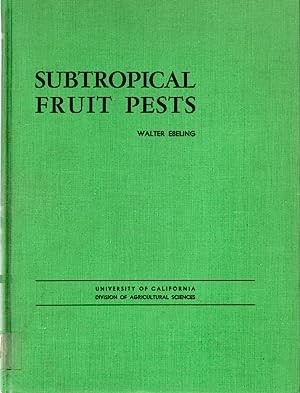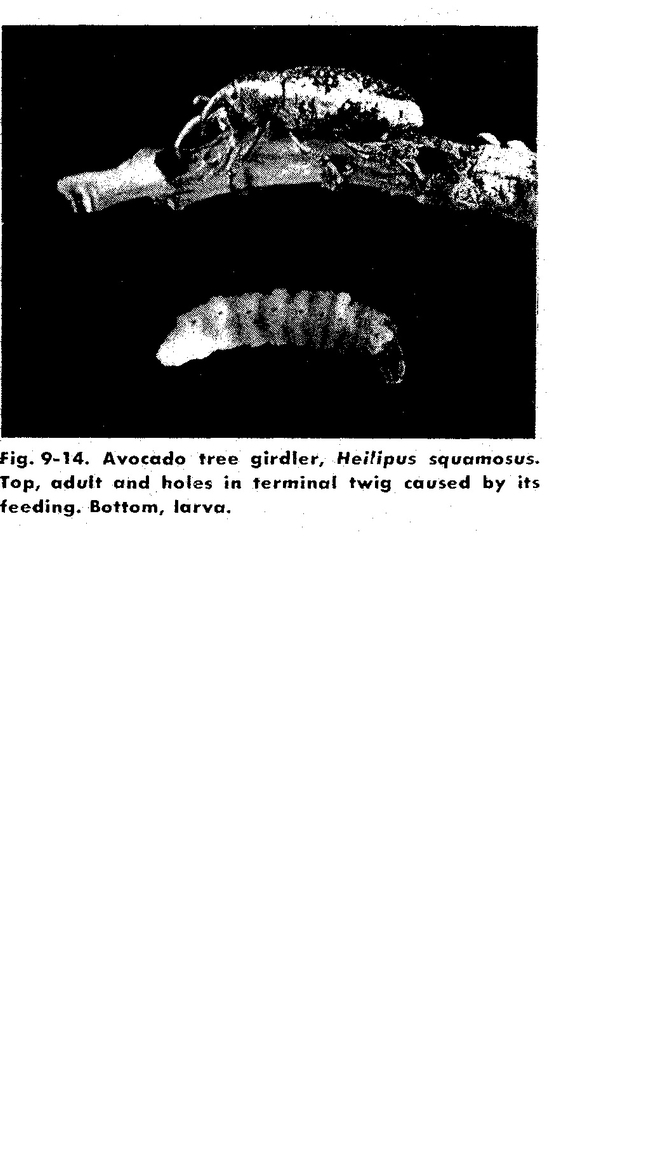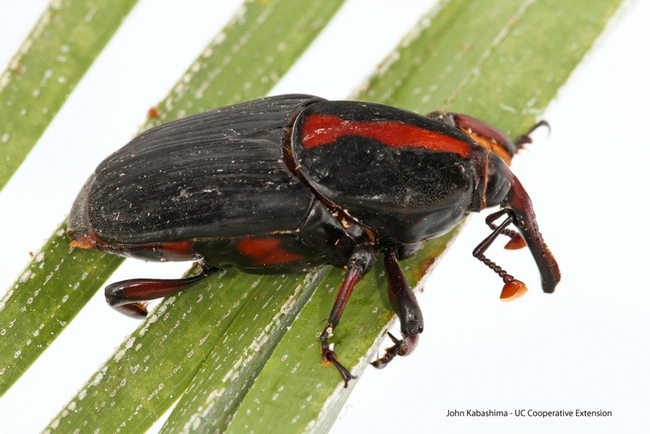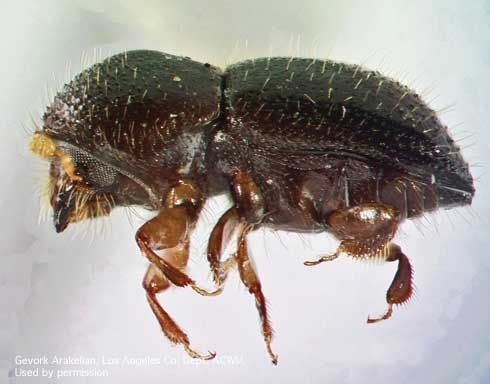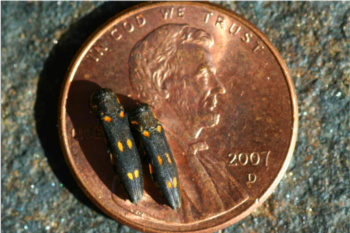
Posts Tagged: pests
Avocado Pests from the Past and Present in ONE Book
I recently went looking for our copies of Walter Ebeling's book on pests of subtropical tree crops. It was created over 40 years ago, but is still a great reference for past pests and those that still pop up with less frequency than avocado thrips and persea mite do today. But both copies have disappeared from the office. and we have a new entomology advisor - Hamutahl Cohen - who is coming up to speed on the pest issues of our coastal area.
But all is not lost. It's online. This is the section of Subtropical Fruit Pests by Walter Ebeling that covers avocado pests in not only California, but what was and is known to exist in other avocado growing regions around the US and the world. It was reproduced at the Hofshi Foundation's Avocadosource website. At this point it only contains the chapters pertaining to avocado. Other chapters in the full text cover citrus, grape, walnut, almond pecan, olive, fig, date and other "Minor Subtropical Fruits". The beauty of the book is not only historical, but that it is still current (although the DDT recommendations are out of date) for many pests. It also chronicles pests that have appeared in the past, disappeared and then reappeared. An example is Avocado Bud Mite - here, gone, here and seemingly gone again, probably to reappear sometime in the future. This is no replacement for the UC-IPM website, http://ipm.ucanr.edu/PMG/crops-agriculture.html , but it is a good look at how the pest has been managed in the past and is done so currently. http://www.avocadosource.com/papers/research_articles/ebelingwalter1959b.pdf
I thought I had the only copies of this book in Ventura County, but you could too. There are some listed on ABE Books for cheap, which is where I got our replacement. At one point the University of California made hard copies of all manner of valuable material available for cheap or free. It still does, but much is online now. Check out the selections: https://anrcatalog.ucanr.edu/
This pestiferous book was compiled by Walter Ebeling at UC Riverside/Los Angeles. He was of some note, considered the Father of Urban Entomology. As you can see from the descriptions of avocado pests, he was a good all round entomologist, as well. Urban entomology really forces you to know a lot because of the diversity of arthropods in urban settings. He passed in 2010 and was recognized world-wide for his work.
Bird Control of Pests Webinar - CEUs
DPR funds educational resources to increase the adoption of reduced-risk, sustainable pest management practices for farmersAs part of DPR's goal to accelerate the transition to safer, more sustainable pest management and fulfill its mission to foster reduced-risk pest management, DPR has funded a project with Wild Farm Alliance (WFA) to provide educational resources for farmers to encourage the use of beneficial birds for pest control. When beneficial birds are supported, they can sustainably reduce pest insects and rodents that cause crop damage. Wild Farm Alliance created two free Continuing Education Courses about supporting avian pest control. The courses are online and can be taken any time throughout the year. These courses are approved for CE credit through DPR. Habitat on Farms Support Avian Pest Control Services (4 CE Units) Participants will learn about research that shows the benefits of installing habitat in and around farms to attract beneficial birds that provide valuable pest control services. Nest Boxes and Perches on Farms Support Avian Pest Control Services (3 CE Units) Participants will learn about the research showing the benefits to the farm of installing Western Bluebird and other songbird nest boxes, Barn Owl and American Kestrel boxes, and songbird and raptor perches to gain these birds' valuable pest control services. DPR's Integrated Pest Management Branch is supporting the use of sustainable pest management strategies in our state in a variety of ways, including funding these educational courses on beneficial birds for Pest Control Advisors and pesticide applicator license and certificate holders. https://content.govdelivery.com/accounts/CADPR/bulletins/35b24c1
|

sparrow lupine
Scientists make inroads against tree-killing pests
Randall Oliver, UC Statewide IPM Program Communications Coordinator.
Credit: An adult male red striped palm weevil.John Kabashima/UCANR
Trees provide shade to keep us cool, produce oxygen for us to breathe and calm our nerves. Numerous studies have demonstrated that even brief contact with trees and green spaces can provide significant human health benefits such as reductions in blood pressure and stress-related hormones. Trees also reduce noise and visual pollution, help manage storm water runoff, reduce erosion and provide habitat for birds and wildlife. Trees naturally capture carbon, helping to offset the forces of climate change. They also increase the value of our properties and communities. In short, trees are essential to our well-being.
Unfortunately, invasive pests pose an ongoing threat to California's forests in both urban and wildland settings. Invasive insects such as goldspotted oak borer and invasive shothole borers have killed hundreds of thousands of trees in Southern California and are continuing to spread. Meanwhile, other pests and diseases such as Mediterranean oak borer and sudden oak death are killing trees in Northern California.
While the situation may sound dire, it is not hopeless. Of course, the best way to stop invasive pests is to prevent them from entering the state, as the California Department of Food and Agriculture has done on many occasions. For example, several months ago, CDFA border inspectors seized a load of firewood containing spotted lanternfly eggs (a pest that is causing extensive damage on the East Coast). When pests do sneak in, the next defense is to catch them early before they become established. Finally, even if pests do become established, they can be managed if not completely eradicated.
A few examples may help to illustrate why invasive tree pests deserve action, but not panic.
Red striped palm weevil eradicated in Laguna Beach
When red striped palm weevil, a highly destructive palm pest native to Indonesia, was discovered in Laguna Beach in October 2010, a working group was quickly formed to develop a management plan. The small but diverse group included international palm weevil experts, research scientists from University of California Riverside, CDFA and U.S. Department of Agriculture, UC Cooperative Extension personnel from San Diego, Orange and Los Angeles counties and county entomologists from the agricultural commissioner's offices in Orange and San Diego counties.
The resulting response included a pheromone-based trapping program, public advisory and targeted insecticide treatments. Within two years, additional trapping and inspections could not find any signs of continued infestations. Early detection was key to the success: the infestation in Laguna Beach was identified early, so the weevil population was still relatively small. In addition, Laguna Beach is geographically isolated, the local climate is much cooler than the weevil's place of origin, and the eradication effort was well funded by state and federal agencies. Eliminating invasive pests where such conditions are not present may prove more difficult.
Invasive shothole borers attack Disneyland
Credit: Gevork Arakelian, Los Angeles County Agricultural Commissioner/Weights & Measures.
The Disneyland Resort in Anaheim contains 16,000 trees and over 680 different tree species. When park officials identified an infestation by invasive shothole borers in 2016, their initial attempts at vanquishing the insects with pesticides produced mixed results. Then, they consulted with experts from UC Riverside and UC Cooperative Extension and together designed and followed an integrated pest management program that included monthly ground surveys, a trapping program that helped to detect infestation hot spots and find and remove the source of beetles, and occasional pesticide treatments on selected trees. The park went from a large number of beetles in 2017 to very low levels today. There are still some beetles, but resulting damage is extremely low, and although monitoring programs continue, the park's landscape team has been able to turn its focus elsewhere.
Goldspotted oak borer spotted in Weir Canyon
When goldspotted oak borer was confirmed in Orange County's Weir Canyon in 2014, a team from Irvine Ranch Conservancy (IRC), the organization that manages the area on behalf of Orange County Parks, sprang into action. UC Cooperative Extension and the US Forest Service assisted IRC in developing a management program, and over the ensuing years, IRC has actively collaborated with OC Parks, The Nature Conservancy, OC Fire Authority, and CAL FIRE to control the existing infestation and stop its spread. IRC has surveyed the oaks in the area yearly to monitor the infestation and guide each year's management actions.
To reduce the spread of the infestation, IRC removed more than 100 severely infested oaks in the first few years of management (no severely infested oaks have been found in the last few years of surveys). Additionally, more than 3,000 tree trunks have been sprayed annually in the late spring to kill emerging adult beetles and newly hatched offspring.
In the most recent survey of the oaks in Weir Canyon, the IRC team found only 12 trees with new exit holes, and most of those had just one to two exit holes per tree, which is an extremely low number. With the situation well under control, IRC is now considering modifying its annual spraying program and adapting other less aggressive treatment options. Finally, IRC has been actively planting acorns to mitigate losses due to the removals as well as the Canyon 2 Fire of 2016.
As these brief examples demonstrate, insect pest infestations can be managed or even eradicated if caught early enough. Early detection not only increases the chances of success, but also minimizes the cost of pest management efforts.
What you can do to prevent infestation
While management actions will vary depending on the insect or disease, species of tree and location, there are a few steps that will lead to greater success in fighting tree pests and diseases.
- Keep your trees healthy. Proper irrigation and maintenance go a long way toward keeping trees strong and resistant to pests and diseases.
- Check your trees early and often for signs and symptoms of tree pests and diseases. These may include entry/exit holes, staining, gumming, sugary build-ups, sawdust-like excretions, and branch or canopy dieback. Use available tools like the UC IPM website to determine probable causes of the problems.
- Talk with experts (arborists, pest control advisers, researchers and advisors from the University of California and other institutions), and report pest findings to your county Agricultural Commissioner.
- Evaluate the extent of tree damage and determine a management plan. Remove severely infested branches and trees that may be a source of insect pests that can attack other trees.
- Properly manage infested wood and green waste. Chip wood and other plant materials as small as possible. Solarization or composting can further increase the effectiveness of chipping. It is generally best to keep those materials close to where they originated, but if you absolutely need to move them, first make sure the facility where they will be sent is equipped to process them. Always tightly cover materials while in transit. If working with a tree care professional, insist that proper disposal is part of the job requirements.
- Many invasive tree pests can survive in down wood for long periods. When buying or collecting firewood, always obtain it as close as possible to where you are going to burn it and leave leftover firewood in place.
Vertebrate Pests in Trees
All good stuff for anyone growing trees - Pests or Pets?
Vertebrate Pests
A big thank you to our Speakers
Click Here for the April Seminar/Webinar Recording

ground squirrel 1
Give a Fig. Pests Might Not Like It.
Sometimes distant relationships are better than close relationships.
https://ucanr.edu/blogs/blogcore/postdetail.cfm?postnum=43912
Persimmons, asparagus, figs and other crops distantly related to native California plants attract fewer pests and diseases than the closer kin, and thus receive fewer pesticide treatments, according to a newly published article by two UC Davis-linked scientists in the Proceedings of the Natural Academy of Sciences (PNAS).
Co-authors Ian Pearse, research ecologist with the U.S. Geological Survey and a UC Davis alumnus, and Jay Rosenheim, UC Davis distinguished professor of entomology, analyzed the 2011-2015 state records of pesticide applications of 93 major California crops.
“We hypothesized that California crops that lack close relatives in the native flora will be attacked by fewer herbivores and pathogens and require less pesticide use,” said Rosenheim, a 32-year member of the UC Davis Department of Entomology and Nematology faculty and a newly elected fellow of the Entomological Society of America.
Rosenheim and Pearse examined the pesticide applications against arthropods, pathogens, and weed plants and compiled the data into a comprehensive analysis.
Their findings appear in the PNAS article, “Phylogenetic Escape from Pests Reduces Pesticides on Some Crop Plants,” published Oct. 12. “Phylogenetic relationship” refers to the relative times in the past that species shared common ancestors.
“It is well understood that many of the insect pests and diseases that attack our crops are often invasive species that come from overseas,” Rosenheim explained. “Almost all crops grown in California have been domesticated from wild plants whose area of origin is overseas, and many of the invading pests come from the original home of the wild ancestor of the now domesticated crop plant.”
“In contrast, our study focuses on the roughly half of all herbivores and diseases that attack California crops and that are actually native to California. These organisms originally attacked members of the native California flora, but have now shifted to attack a novel host: the crop plant.”
However, “host shifts aren't always easy,” Rosenheim said. “It's relatively easy to shift to attack a close relative of a native host plant, but it's relatively hard to shift to attack a very different host plant.”
Said Pearse: “Our study shows that crops like dates, asparagus, figs, kiwis, or persimmons that are distantly related to native California plants--and thus separated by many million years of independent evolution-- are colonized by fewer pests and diseases.”
These crop plants, the scientists said, are “too different” to be attacked readily. As a result, fewer pesticide applications are needed to protect those crops. “Thus, we can capitalize on an understanding of the evolutionary relatedness of crops and native plants to find crops that will suffer less attack, and that can therefore be grown with less use of toxic pesticides,” Pearse pointed out.
"The crops that require the most pesticide applications, Pearse said, "are those, like artichokes, blackberries, and sweet corn, that have close relatives in the Californian flora and are of high economic value per acre."
California's top agricultural crops include almonds, grapes, lettuce, strawberries, tomatoes and walnuts.
Rosenheim said persimmons are a good example “of the phenomenon we've studied: they have very, very few pests--almost zero in my experience--and that's probably because persimmons have no close relatives in the California native plant community.”
Pearse, a 2005 Fulbright scholar who received his doctorate in ecology from UC Davis in 2011, studying with Professor Rick Karban, joined the U.S. Geological Survey in Fort Collins in 2016. He focuses his research on invasive species and plant-insect interactions. Rosenheim researches insect ecology, with a focus on host-parasitoid, predator-prey, and plant-insect interactions, with direct applications to biological control.
“Pesticides are a ubiquitous (found everywhere) component of conventional crop production but come with considerable economic and ecological costs. We tested the hypothesis that variation in pesticide use among crop species is a function of crop economics and the phylogenetic relationship of a crop to native plants, because unrelated crops accrue fewer herbivores and pathogens. Comparative analyses of a dataset of 93 Californian crops showed that more valuable crops and crops with close relatives in the native plant flora received greater pesticide use, explaining roughly half of the variance in pesticide use among crops against pathogens and herbivores. Phylogenetic escape from arthropod and pathogen pests results in lower pesticides, suggesting that the introduced status of some crops can be leveraged to reduce pesticides.”
Coffee, anyone?
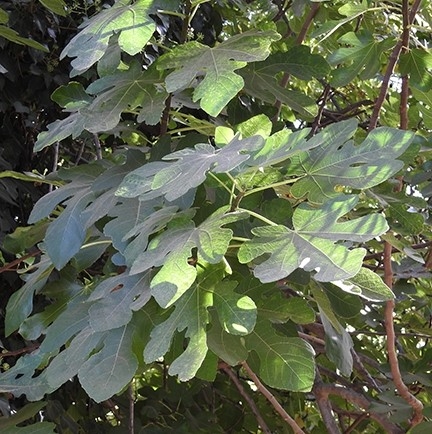
fig leaves

